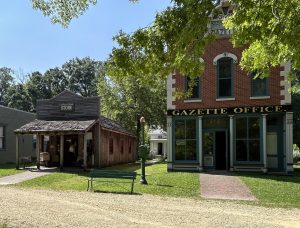Midway Village Museum celebrates Rockford region’s past, present
By Lynne Conner for Chronicle Media — August 7, 2024
A general store and newspaper office are part of the Midway Village Museum’s Living History Village. (Photo by Lynne Lynne Conner/for Chronicle Media)
In celebrating its 50th anniversary, the Midway Village Museum captures Rockford’s
history like a richly detailed mural of the people, industry and technology that define the city.
“The Rockford community is so fortunate to have the Midway Village Museum because
it’s where the story of Rockford is told,” said Luke Fredrickson, museum marketing director. “The museum showcases Rockford’s immigrant history, industrial prowess, contributions to women’s sports, and notable advances in aviation and technology.”
The museum’s main building has undergone additions over the years to accommodate
collection storage, classrooms, exhibit galleries, a gift store, staff offices and meeting rooms.
“During the 1980s, a gallery to showcase Rockford’s industrial history was built at the south end of the museum, which was later connected to the gallery that houses the Rockford Peaches and sock monkey exhibits,” Fredrickson said.
The most recent addition honors Rockford’s diverse heritage.
“In 2010, we opened the permanent exhibit, ‘Many Faces One Community,’ which details the contributions different ethnic groups made to our city,” Fredrickson said. “In this gallery, visitors can walk down a replica of 7th and South Main Streets circa 1900 and learn about the trades Swedish, Irish, Italian, African American and Hispanic immigrants brought to Rockford.”
A new permanent exhibit is on the horizon.
“In early 2025, we will be opening ‘You’re in the Army Now. Camp Grant, Rockford’s Legacy,’ which tells the story of the military camp’s construction and commissioning in 1917, the role it played during World War II and how the camp was used between wars,” Fredrickson said.
“Many of the artifacts we have for this exhibit came from the Command Post Restaurant and Museum near the Chicago-Rockford International Airport that closed in 2020.”
Beyond the main building, the museum has an outdoor living history village with actual buildings and replica structures representing life in Rockford during the 1890s-1910s.
“The Living History Village is now about 145 acres, which includes 26 buildings and open fields that are used for our war reenactment events,” Fredrickson said. “The first eight historical buildings were moved to the property by the early 1980s, and over a dozen replica buildings were constructed to create a ‘town’.”
The concept for a museum center came about during the late 1960s as a collaboration between the Rockford, Harlem and Swedish Historical Societies.
“As they were raising money for the museum, part of the land for the project was donated by Carl Severin, the father of our current board member, Britta Peterson, and the first museum building opened on June 16, 1974,” Fredrickson said.
Some of the most popular buildings in the village include a general store, a functional
blacksmith shop, a working print shop, a hotel and a schoolhouse. Generations of area
students and summer camp groups have enjoyed visiting the village and experiencing a typical day in the 1900s.
Many field trip groups have spent a school day at the village schoolhouse, where
teachers and students dress in clothing of the era, pack lunches in metal buckets and use a chalkboard to learn and complete lessons.
“The Midway Village Museum is an interactive multigenerational place,” he said. “Families can experience living history by exploring the schoolhouse, blacksmith shop, or hotel and learning from our volunteer historical interpreters. It’s a place that connects us to our community and strengthens the ties between everyone.”
The Midway Village Museum had an open house on June 16 to celebrate the 50th
anniversary of the facility’s ribbon cutting. Another open house is planned for Aug. 15 in conjunction with Rockford’s 815 Day.
Admission to the museum and outdoor village is free on Aug. 15, with a fundraising dinner that night to benefit the Midway Village Museum Foundation. For more information, visit www.midwayvillage.com







